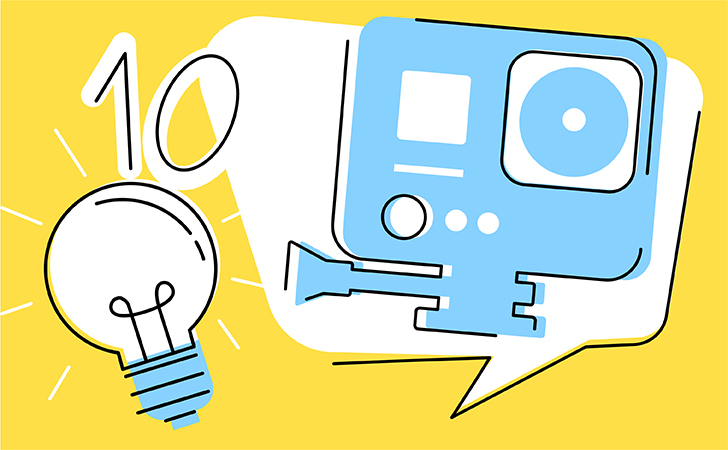We use cookies to improve the services we offer you. By continuing to browse this site, you consent to keep them in accordance with our Privacy Policy.
×We use cookies to improve the services we offer you. By continuing to browse this site, you consent to keep them in accordance with our Privacy Policy.
× 4,561
4,561
 5 min
5 min

A GoPro camera is a must-have for travel addicts and adrenaline junkies. This little device is capable of transforming your adventures into full-fledged blockbuster movies – as long as you know how to use it right.
Most people know that GoPro cameras (synonymous with action cameras) are small, easy to operate, water- and dirt-resistant, and good at capturing motion. However, there is much more to GoPro filming when you actually delve into it. Here are some tips for making your future features look more professional – so that you and your viewers will want to watch and share them over and over.
There are tons of third-party devices and accessories for your GoPro out there on the market. Basically, with the right tool, you can attach your camera to pretty much anything. Get yourself a simple handgrip and a few straps to start with. Later on, once you figure out what you need, you might consider purchasing more advanced gear such as a gimbal or a GoPro Dome. Check out these YouTube reviews to make an informed choice.
There is almost no wrong way to use an action camera. You can mount it on a helmet, use straps to attach it to your body, put it on vehicles, bicycles, boats, boards, even animals… The best way to find out what works best for you is to just experiment. But remember that the shakier your image is, the harder it will be to watch, so try to stick to objects that are stable or move smoothly. Whenever possible, use gimbals and other stabilizing gear.
You might find it a waste of time to think things through in advance when you first start experimenting with your GoPro. However, if you’re really looking to elevate your GoPro filming skills to a pro level, even a few notes written on a piece of paper will help you follow your scenario and minimize the chance you’ll forget something important.
Although the default settings of a GoPro are usually quite good to start with, a true wanna-be pro will want to dig into the settings. The first thing to consider is the frame rate. A standard 24 FPS will give your footage a more cinematic look, while 60 FPS ensures smoother motion and much more detail. This means that, for quality slow-motion shots, you will need to set your frame rate to 120 FPS. Think about the resolution, too: as tempting as recording in 4K might be, you’re likely to end up with extra-large files that will be hard to work with – sometimes it’s better to stick with 1080p to avoid the hassle.
Always remember that GoPro cameras usually shoot at a wide angle. This means that, if you want to emphasize a certain object, it has to be close to your lens – much closer than it would be if you were shooting on a regular SLR with a standard lens. To avoid distortion, try to keep your subjects (people, in particular) in the center of the shot.
Get as many shots as possible – even if this involves capturing the same thing multiple times. Shoot from various angles, change the distance between yourself and the object, switch between still and dynamic shots – variety is the name of the game. The aim is to get a range of aspects to choose from. Consider taking advantage of special shooting techniques like timelapse, as well. There are tons of creative ideas out there on the internet – look at what other filmmakers have done with their action cams.
Most shots don’t need to last longer than 2–4 seconds unless there is a particular action happening. There are some great single-shot GoPro videos out there, but most of the time this trick caters to a specific genre (e.g. a day from someone’s life), and these clips are usually sped up a few times.
Enjoy our special discount for all blog readers!
Promocode: SUPERBLOG
Download Movavi Video Editor Plus with 10% discount for Windows
Download Movavi Video Editor Plus with 10% discount for Mac
Make your video smoother by applying some dynamic transitions and other special effects. GoPro videos are a good ground for experiments – if you’re using Movavi Video Editor, try different types of Warp, Twist, Zoom or opt for specific effect packs such as the Travel Blog Pack from the Movavi Effects Store.
If you’re planning to use a soundtrack, choose it before starting to edit and cut your video onto the track. Try to play around with the rhythm of the music and emphasize highlights. Remember, it’s the soundtrack that usually defines the overall tone and atmosphere of your video.
There are so many GoPro videos out there, yet so few of them have an actual narrative. To make your clip truly stand out, try to think beyond the technical aspects and articulate the story you want to share. Look for inspiration by taking a look at what’s attracting appreciative viewers on the internet – for example, check out this little Kitty Rescue movie.